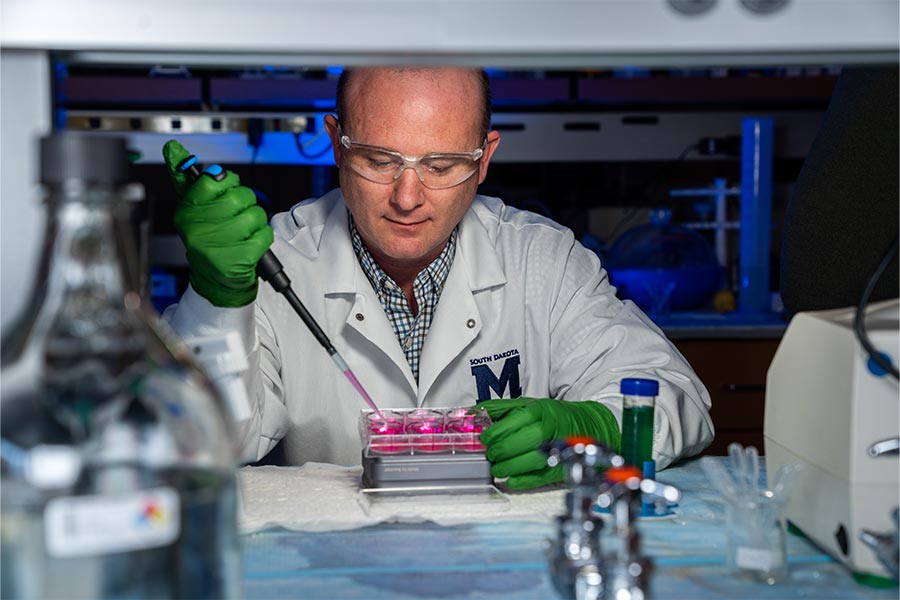A South Dakota Mines research team has developed technology – and established a subsequent startup company – that could be a key to finding a cure for osteoarthritis.
Scott Wood, Ph.D., an assistant professor in the NanoScience and NanoEngineering Program, and Ph.D. student Ram Saraswat lead the research and development of the nanoscience technology now utilized by their startup, CellField Technologies. “We’re excited about the potential future of the technology and the company,” Wood says. “We hope it will be a gamechanger in osteoarthritis research.”
Osteoarthritis, sometimes called degenerative joint disease, is the most common form of arthritis. Most often it occurs in the hands, hips and knees. Osteoarthritis develops when the cartilage within a joint begins to break down, causing pain, stiffness and swelling. More than 32.5 million adults in the United States suffer from osteoarthritis, and current treatments offer little more than temporary pain control, Wood says.
Wood says that for hundreds of years, doctors have considered osteoarthritis a “wear and tear disease, but we know now that it’s more complicated … It’s actually an imbalance of the behavior of the cells in the joint.”
Wood says CellField’s technology will make it easier to study cartilage cells, called chondrocytes, the primary cells that cause osteoarthritis, in a lab setting.
“Currently when cartilage cells are removed from the body to be studied in a traditional 2D culture system, they are notoriously difficult to work with because they basically transform into a completely different cell type within a week and a half,” Wood says. More advanced 3D culture systems prevent this from happening but create incompatibility with techniques to analyze the cells. “Our technology is meant to keep those cells behaving in the lab the way they would in the body without limiting our ability to study their behavior.”
The technology developed by Wood and Saraswat – a combination of nanotechnology, micropatterning and “mechanically-tunable” thin-film composite materials, and B9Creations technology – acts as an “egg crate for individual cells, nesting each one in an environment that allows it to maintain its physiological nature without restricting their ability to be studied.” It can “maintain the physiological cell shape of chondrocytes for at least 28 days, four times as long as competing micropatterned technologies.”
Wood says the new technique will allow scientists to evaluate the cartilage cells as a part of the entire joint, which has multiple types of cells that communicate with each other. Most research to date involves studying the chondrocytes independently of the other cells in a joint. Wood’s research uses “traditional and state-of-the-art genome, proteomic and imaging techniques” to study the cells. The ultimate goal is a type of a “joint on a chip” device.
The term “joint-on-a-chip” is an evolution of “lab-on-a-chip,” which is a class of device that meshes and automates multiple lab techniques into one system that could fit on a chip no bigger than a few square centimeters in size. By consolidating the techniques onto one small chip, researchers like Wood can study the cells in a cost-effective, efficient and productive environment. “More data for less money and less time.”
Once the technology for stabilizing the chondrocytes had been developed by Wood and Saraswat, they sought to identify how it could be utilized by researchers and industry members. To do that, Wood and Saraswat built a team that included University of South Dakota business student Thane Hein and Mines Entrepreneur-in-Residence Russ Enns, landing a $50,000 National Science Foundation I-Corps grant in July 2020.
The team also received grant funding from the Governor’s Office of Economic Development and assistance from DRACO, a South Dakota nonprofit organization that advises startup companies and entrepreneurs.
NSF I-Corps grants are not research grants but instead commercialization grants designed to identify whether there is a market for research developments. Teams create YouTube videos, interview business leaders and research market need for their businesses. Initially, the team expected to sell their “widget” to academic researchers and “big pharma” companies. Instead, after interviewing more than 121 leaders in business and commercial enterprises, they learned that big pharmaceutical companies are not working on research to modify the disease or cure it and that pharmaceutical companies typically contract out their pre-clinical research.
Small to mid-size pharmaceutical companies, with 1,000 or less employees, are the ones focused on osteoarthritis cures. As a result, the CellField team realized that the best use of their technology is for CellField to work as a contract research company for those smaller pharmaceutical companies. “What we learned from I-Corps was that the company should not be a manufacturing company but a research company,” he says. “It’s the smaller startup companies and mid-sized pharmaceutical customers who we think will be our target market initially.”
Wood says researchers are “a long way out on discovering a cure for osteoarthritis, but we think that if we’re able to develop this company and our technology … that should really speed things up.”
Currently, the team is working on prototype development based on feedback from their I-Corps research. They are also seeking to add additional leadership on the business side of the startup. But the work continues, with improvements and new technology still being discovered in the lab.
“We’ve got some exciting new developments that we’re working on in order to meet the needs of pharmaceutical scientists,” Wood says. “And we hope that because of our work we can someday see a cure for this debilitating disease.”
* This case study was reposted from South Dakota Mines' research blog. Read the original article here.
Learn More About B9Creations' 3D Printing Solutions for Biomedical Engineering and Research


